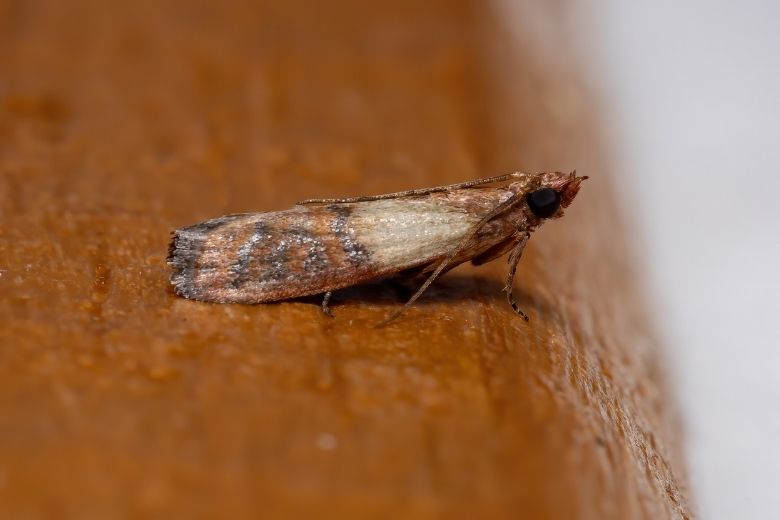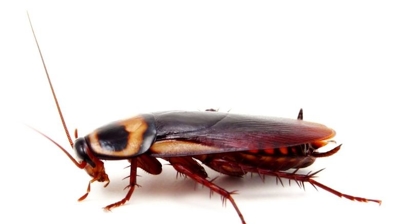
Indian Meal Moth Control Services

Indian Meal Moths
Indian meal moths (Plodia interpunctella) are considered harmful primarily because of the damage these moths cause to stored food products and their potential to contaminate human food. Here are some of the ways they are harmful:
- Larvae as the main culprits: The larvae (caterpillars) of Indian meal moths infest dry foods such as grains, cereals, flour, nuts, dried fruit, and pet food.
- Webbing and frass: The larvae spin silk webbing in infested food, which can bind clumps together and make the food unusable. They also leave droppings (frass), which further contaminates the product.
- Microbial growth: The contamination from their droppings and webbing can encourage mold and bacterial growth in food, increasing health risks.
- Food wastage: Infested food usually has to be discarded, causing financial loss to households, grocery stores, and food storage facilities.
- Storage damage: They can infest large quantities of stored products, particularly in warehouses or pantries, leading to significant economic impact.
- Dust and particles: The frass, shed skins, and webbing can act as allergens. Some people may experience mild respiratory irritation or allergic reactions after exposure, especially in sensitive individuals.
- Fast reproduction: Indian meal moths reproduce quickly, and a small infestation can escalate to a large problem in a matter of weeks.
- Difficult eradication: Once established, they can spread to multiple stored food items and neighboring areas, making them hard to control without thorough cleaning or professional intervention.
- Unpleasant experience: Finding live larvae or webbed food in a pantry is unsettling for many people, causing stress and anxiety about food safety.
Indian meal moths are harmful because they contaminate food, cause economic losses, can trigger allergies, spread rapidly, and create psychological distress. Their impact is mostly indirect, through contamination and destruction of stored products, rather than direct health risks like biting or stinging.
Learn more: Do Indian Meal Moths Bite?
Indian Meal Moth Removal
Indian meal moths (Plodia interpunctella) are more than just a nuisance in pantries—they pose real risks to both food safety and household hygiene. Eliminating them promptly is critical for several reasons:
- Contamination of food: Indian meal moths lay eggs directly on stored food. The larvae feed on grains, cereals, nuts, dried fruits, and other dry goods. As they consume the food, they leave behind webbing, frass (insect excrement), and shed skins, making the product unfit for consumption. Even if the food appears intact, contamination with larvae or frass renders it unsafe and unappetizing.
- Rapid reproduction: These moths reproduce quickly. A single female can lay 100–400 eggs, which hatch into larvae in just a few days. In warm conditions, multiple generations can develop in a single season. This exponential growth means an untreated infestation can spread from one container of food to many, quickly affecting an entire pantry.
- Food waste and economic loss: Infestations can result in significant food loss. Once a product is infested, it typically must be discarded entirely. For households, this is inconvenient and costly; for businesses, especially food storage or retail operations, it can lead to substantial financial losses and supply chain disruption.
- Difficult eradication once established: Indian meal moths are notoriously persistent. Eggs are tiny and often go unnoticed, and larvae can hide in cracks, crevices, and packaging. Once an infestation takes hold, eradication requires careful cleaning, disposal of contaminated items, and ongoing monitoring, often combined with pheromone traps and chemical or natural controls.
- Health considerations: While these moths are not known to transmit diseases, consuming infested products can cause digestive discomfort. Additionally, the presence of insects in food can trigger allergic reactions in sensitive individuals.
- Prevention of secondary infestations: Indian meal moths can attract other pests. For example, their webbing and frass may draw ants or other insects into the home, compounding the problem.
Because of their rapid lifecycle, high contamination potential, and persistence, prompt detection and removal of Indian meal moths are essential for maintaining food safety, hygiene, and household economy.
Learn more: How To Get Rid Of Indian Meal Moths
Indian Meal Moth Control
Hiring our professional pest control services for Indian meal moths is highly recommended because these moths are surprisingly resilient and difficult to eliminate completely with DIY methods. Here’s why our professional intervention is the most effective approach:
- Correct species identification: Many pantry pests look similar; our professionals can accurately identify Indian meal moths versus other pantry pests, ensuring the right treatment plan.
- Thorough inspection: Our professionals know where to look—pantries, cupboards, food storage areas, pet food containers, and even hidden cracks or corners. We can identify the full scope of the infestation, which is critical for successful eradication.
- Effective pesticides and treatments: Our professionals have access to pest-control solutions that are more effective than over-the-counter products. We know how to apply them safely in food storage areas without contaminating edible items.
- Integrated pest management (IPM): Our experts often combine chemical treatments with non-chemical strategies—like varying types of traps, and sanitation advice—to prevent recurrence.
- Safety precautions: We minimize risks to humans, pets, and sensitive food items, which DIY treatments sometimes compromise.
- Identify and remove food sources: Our professionals guide homeowners on what food to discard, how to store food properly, and where potential re-infestation points exist.
- Long-term monitoring: We provide ongoing protective visits, inspections, and traps to ensure the moths are completely gone and prevent new infestations.
- Comprehensive service: A DIY approach can be labor-intensive, requiring thorough cleaning, bagging, discarding, and ongoing monitoring. Our professionals handle all of this efficiently.
- Peace of mind: Knowing that our experts have resolved the infestation reduces stress, especially when children or pets are present.
- Avoid repeated mistakes: DIY attempts often fail, meaning repeated purchases of traps or insecticides and wasted time. Our professional treatments are more likely to fully eliminate the problem the first time.
- Protect food inventory: For households or businesses with large pantries, our professional intervention can help mitigate and prevent extensive food loss.
Indian meal moths are deceptively persistent. Our professionals provide precise identification, effective and safe treatment, guidance on prevention, and long-term monitoring—things that are difficult to achieve on your own. Attempting to handle a serious infestation without our expertise often only reduces the population temporarily, allowing the moths to return.
Indian Meal Moth Exterminators
When it comes to Indian meal moths, hiring our local exterminators provides distinct advantages over using a national pest control company. Here’s why our local specialist are more effective:
- Deep knowledge of local infestations and conditions: Indian meal moth populations can vary regionally depending on climate, food storage habits, and local pest pressure. Our local exterminators understand these nuances, such as which foods or storage practices in the area are most vulnerable and when infestations typically peak. National companies often rely on standardized protocols that do not account for these local variations, potentially making treatments less precise.
- Targeted, experience-based strategies: Our local exterminators have hands-on experience with the specific types of infestations common in the area, including hidden hotspots like pantries, cupboards, or commercial food storage areas. We know which traps, baits, and cleaning protocols consistently work against Indian meal moths locally, rather than relying solely on broad chemical treatments.
- Faster response and personalized service: Our local professionals can typically respond more quickly to a call, inspect your home in person, and develop a tailored plan. National companies often schedule visits days or even weeks after you call, send technicians unfamiliar with the area, and apply generic solutions that often require multiple follow-ups. Indian meal moths reproduce rapidly, so these delays in treatment often allow the infestation to escalate.
- Accountability and long-term follow-up: Hiring locally creates a relationship where our reputation depends on your satisfaction. We are invested in ensuring the moths are fully eradicated and provide ongoing advice and services to ensure your satisfaction. National companies often rotate staff and rely on rigid service contracts, which makes follow-up less personalized and effective.
- Expertise in prevention and storage recommendations: Our local pest control professionals provide actionable advice on how to prevent reinfestation, including specific storage practices, pantry cleaning schedules, and monitoring techniques that have proven effective in your community. This level of practical guidance is more nuanced than what a national chain offers.
- Knowledge of local regulations and safe practices: Certain pesticides or food-safe treatments may be regulated differently depending on state or county guidelines. Our local exterminators are well-versed in these rules and apply our treatments safely and legally.
For Indian meal moths specifically, where success relies heavily on identifying food sources, meticulous cleaning, and repeated monitoring, our local expertise makes a significant difference. National companies and their “one-size-fits-all” approach often leave residual larvae and eggs behind, resulting in recurring infestations.
What Do Indian Meal Moths Look Like?
Indian meal moths (Plodia interpunctella) have a distinct appearance that makes them recognizable once you know what to look for. Here’s what they look like:
Adult Indian Meal Moths
- Size: Small, about ⅜ inch (8–10 mm) in length with a wingspan of roughly ½ inch (12–16 mm).
- Coloration:
- Forewings: The front half near the head is pale gray or light tan. The back half toward the wingtips is reddish-brown or coppery with a metallic sheen.
- Hindwings: Lighter in color, usually grayish or whitish, and fringed with fine hairs.
- Shape: Slender body with wings folded over the back when at rest, forming a triangular shape.
- Behavior: They tend to fly erratically in short bursts and are often seen near pantry lights or food sources.
Larvae (Caterpillars)
- Size: About ½ inch (12–14 mm) when fully grown.
- Color: Creamy white or pale yellow body with a brown head capsule. Some larvae may have a pinkish or greenish tinge depending on their diet.
- Features: Small legs near the head; soft-bodied and slightly translucent.
- Behavior: These are the damaging stage—they spin silk webbing over infested food and leave behind frass (droppings).
Eggs
- Appearance: Tiny, whitish, and often laid directly on food surfaces.
- Visibility: Difficult to see without magnification, which is why infestations often go unnoticed until larvae appear.
Where Are Indian Meal Moths Found?
Indian meal moths (Plodia interpunctella) are pantry pests, so you’re most likely to encounter these moths in areas where dry food is stored. Their preferred habitats are warm, dark, and undisturbed areas with easy access to food. Here’s where to find Indian meal moths:
Kitchen and Pantry
- Stored grains: Rice, wheat, corn, oats, and other cereals.
- Flours and baking ingredients: All-purpose flour, cornmeal, cake mixes, and baking powder.
- Dried fruits and nuts: Raisins, dates, almonds, walnuts, and similar foods.
- Snack foods: Crackers, chips, pet food, and chocolate.
- Spices: Some heavily processed spices can also harbor eggs or larvae.
Look behind boxes, bags, and containers, because moths often infest the underside or corners of packages.
Cabinets and Cupboards
- Indian meal moths prefer dark, enclosed spaces that are rarely disturbed.
- They can hide in cracks, corners, and along shelf edges.
- Once larvae hatch, they may crawl from one package to another, leaving silk webbing and frass behind.
Food Storage Areas Outside the Kitchen
- Basements and storage rooms: If dry foods are kept here, they are vulnerable to infestation.
- Pantries in offices or stores: Large quantities of grains, nuts, or snacks are common targets.
- Pet food areas: Dog and cat food in bags or bins are often infested because they provide a rich food source.
Less Obvious Spots
- Cracks and crevices: Moths can lay eggs in small gaps between shelves or wall joints.
- Reusable containers: Even tightly sealed jars or bins can sometimes harbor eggs if food was contaminated before storage.
- Old or forgotten food: Any undisturbed, expired, or rarely used food is at higher risk.
Signs of Indian Meal Moths:
- Webbing over food or container edges.
- Clumping in powders like flour or sugar.
- Small brown specks (frass) in food.
- Adult moths flying around pantry lights, especially in the evening.
What Do Indian Meal Moths Eat?
Indian meal moths (Plodia interpunctella) are generalist feeders, but they have strong preferences for certain types of dry foods. Their larvae are the stage that actually feeds, and this is where most damage occurs. Here’s what Indian meal moths eat:
Grains and Grain Products
- Cereals: Oats, cornflakes, rice, wheat, and other breakfast cereals.
- Flours: All-purpose flour, whole wheat flour, cornmeal, and cake mixes.
- Pasta and noodles: Dried pasta, macaroni, and other similar products.
Nuts and Seeds
- Almonds, walnuts, peanuts, sunflower seeds, and other tree nuts.
- Seeds used in cooking or birdseed.
Dried Fruits
- Raisins, dates, figs, prunes, and dried apricots.
- These provide both nutrition and moisture that supports larval growth.
Snack Foods and Sweets
- Crackers, chips, cookies, chocolate, and candy.
- Some processed foods with grains or sugar are particularly attractive.
Pet Food
- Dog or cat kibble, birdseed, or rodent food stored in bulk.
- Indian meal moth larvae thrive in these because of the protein and fat content.
Spices and Other Dry Products
- Occasionally, ground spices, powdered milk, and powdered drink mixes can be infested.
- They are less preferred but can serve as a food source if other options are limited.
- Larvae are picky about moisture: They prefer dry foods but need minimal moisture from their food to survive.
- Contamination spreads: Once larvae feed, they spin silk webbing, leaving food clumped and contaminated with frass, which makes even non-preferred foods unusable.
Indian Meal Moth Life Cycle
Indian meal moths (Plodia interpunctella) have a complete metamorphosis lifecycle, with distinct stages: egg, larva, pupa, and adult. Their biology and reproductive potential make them highly efficient pests in homes and food storage areas:
Life Stages
Egg
- Appearance: Tiny, whitish or translucent, and often laid directly on or near food sources.
- Quantity: A single female can lay 100–400 eggs in her lifetime.
- Incubation: Eggs typically hatch in 2–14 days, depending on temperature and humidity. Warm, humid conditions accelerate development.
- Vulnerability: Eggs are difficult to detect due to their size and are often the source of hidden infestations.
Larva (Caterpillar)
- Appearance: Creamy white to pale yellow with a brown head; can reach ½ inch (12–14 mm) when fully grown.
- Feeding: This is the damaging stage—they consume grains, cereals, dried fruits, nuts, pet food, and other dry goods, leaving silk webbing and frass.
- Duration: Larval stage lasts 2–41 weeks, heavily dependent on temperature, food availability, and environmental conditions.
- Behavior: Larvae spin silken tunnels in food, which protects them and makes infestations difficult to eradicate.
Pupa
- Appearance: Enclosed in a silken cocoon, often attached to the food container, cracks, or other nearby surfaces.
- Duration: Pupation lasts about 1–4 weeks. Cooler temperatures can prolong this stage.
- Function: This stage is non-feeding; it transforms the larva into an adult moth.
Adult
- Appearance: Wingspan ~½ inch (12–16 mm), with the characteristic forewing pattern: gray near the head, reddish-coppery toward the tips.
- Behavior: Adults are primarily concerned with reproduction and are weak fliers.
- Feeding: Adults do not feed on stored food and live only to mate and lay eggs.
- Lifespan: Usually 1–2 weeks.
Reproductive Potential
- Mating: Occurs soon after adult emergence.
- Egg-laying sites: Females lay eggs on or near food sources to ensure larval survival.
- Generational speed: In optimal conditions (warm, humid, plenty of food), a full life cycle can be completed in 30–40 days, allowing multiple generations per year.
- Population growth: Rapid reproduction means that even a small infestation can escalate into a serious problem quickly.
Environmental Factors
- Temperature: Warmer temperatures speed up development; cooler temperatures slow it down.
- Humidity: Moderate humidity (50–70%) favors egg and larval survival.
- Food availability: Larvae can survive on a wide range of dry foodstuffs, making human homes and food storage areas ideal habitats.
Indian meal moths reproduce quickly, have multiple generations per year, and the larval stage causes the most damage. Their ability to lay hundreds of eggs near food sources and survive in varied environmental conditions makes early detection and our professional intervention critical to preventing severe infestations.

Hear From Our Happy Customers
-
"Professional & Considerate"
I’m pleased with Miche services. Jarvis came today. Professional and considerate. Thank you!
- Judy B. -
"Great Communication"
Tech was on time, communication was great, and he accommodated my needs.
- Alonzo W. -
"Exceeds Expectations"
I can’t say enough positive things about this company... The tech that came out, Jarvis went above and beyond my expectations. Thank you guys, I will continue using your services.
- Jake M. -
"Fantastic & Patient"
Jarvis was fantastic and patient. He answered my questions with an in-depth explanation and addressed all of my areas of concern. Would love for him to be my assigned tech going forward. Well done!
- Yonnette M. -
"Very Knowledgeable"
The tech that arrived was courteous, professional, and very knowledgeable. He was Great.
- Uerial I. -
"Wonderful Service"
Wonderful service. Jarvis is great. Took care of everything I needed. Thank you!
- Henry P.



